Butterflies for Beginners
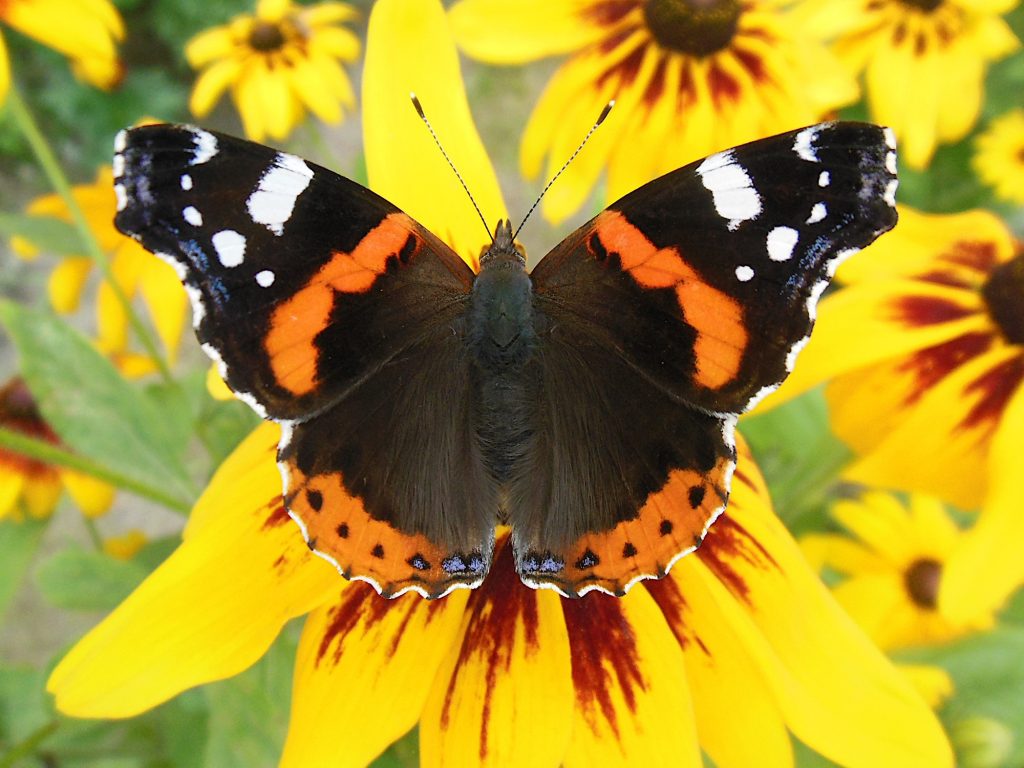
BY NICK CARTER
For naturalists who focus on vertebrates like birds and mammals, the world of insects can seem intimidating, given the millions of species that exist. Thoughts of pinning boards, dichotomous keys, and microscopes can send a shiver down the backbones of those happier with just a pair of binoculars and a birding guide. But my experience is that once you’ve been bitten by the entomology bug, you won’t look back. A good group to start with, if you are keen to expand your biodiversity horizons, is butterflies.
Butterflies provide a good introduction to the world of insects for a variety of reasons. Many species are bright, colourful, and not too hard to find. And because butterflies prefer the midday sun, you don’t have to get up early to spot them, as is the case with many birds and mammals. The distribution of species varies among natural regions, and they exist in their adult stage at different times of year, providing a rotating variety of species from spring to autumn. They don’t bite or sting, and being so approachable, they’re pleasant to watch and enjoy. It’s true that some butterfly species can be challenging to identify, but Alberta does not have so many types that learning the common ones is a chore.
Butterfly Families
To make the most of your butterfly watching it is good to know something about their taxonomy. Butterflies are members of the moth order Lepidoptera. In fact, butterflies are really just a group of colourful daytime moths with club-shaped antennae instead of the feathery antennae of other moths. While many are typical nectar-eating pollinators, some also feed on tree sap or mud. In Alberta there are five major butterfly families to know: swallowtails, skippers, gossamer-wings, whites and sulphurs, and brushfoots. They’re all sufficiently different that identifying a native butterfly down to the family level usually isn’t hard. The accompanying photos provide representative examples from each of the major groups.
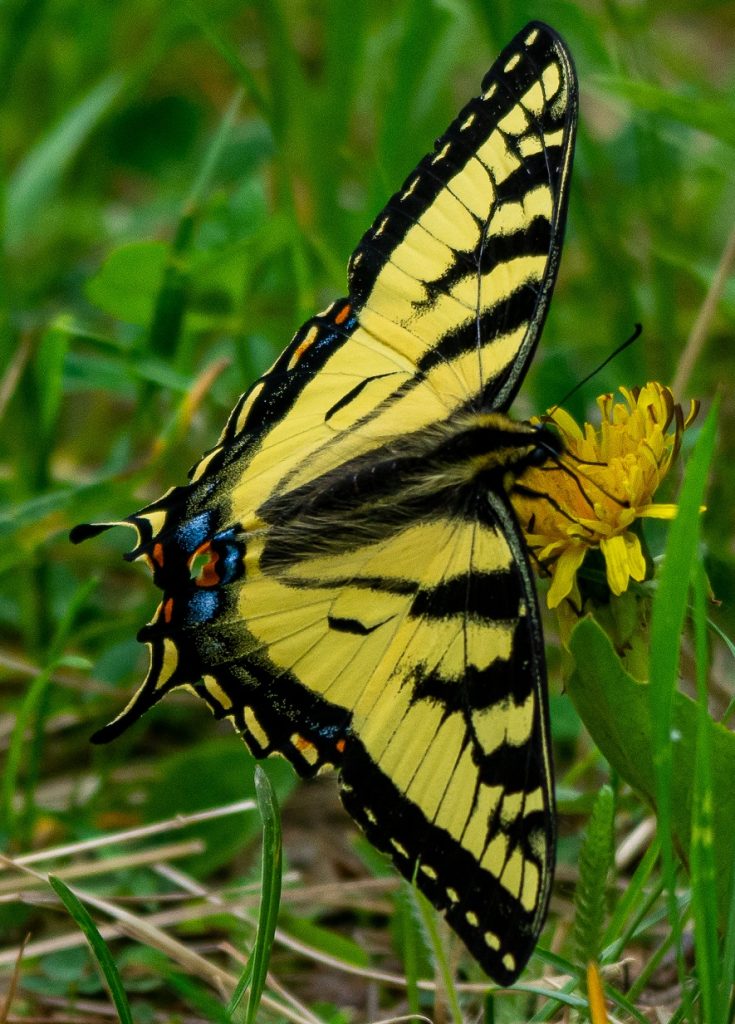
Canadian tiger swallowtail (swallowtail family). This is a large, easily identified butterfly. The wings are bright yellow with black stripes and red and blue spots along the trailing edges. The V-shaped stripe patterns on the wings differentiate it from the Old World swallowtail, which is also common in Alberta. Nick Carter
Perhaps the most noticeable and majestic of Alberta’s butterflies are the swallowtails (family Papilionidae). These big, yellow-and-black butterflies are almost kite-like in appearance, with their trailing wing tassels fringed with blue and orange. The striped Canadian tiger swallowtail is a common species in aspen forests and adjacent meadows. The introduced Old World swallowtail is similar, but has a black base on each forewing instead of the v-shaped stripes of the Canadian tiger. Unlike other butterflies, swallowtails flutter their wings while feeding. The unique relationship between swallowtail butterflies and wood lilies was described in the Fall 2022 issue of Nature Alberta Magazine.
The skippers (family Hesperiidae) are small, short-winged butterflies with distinct hooks on their antennae tips. The forewings are shaped like a right triangle and the hindwings are round. With their big eyes and stubby bodies, skippers are the teddy bears of the butterfly world. They fly in quick darting motions instead of the graceful flight of other butterflies. Skippers can be found in dry grasslands and meadows as well as dense forests, depending on the species. Some are fairly drab and typically “moth-like” in colour, but others are more vivid. Common species include the orange-and-black Arctic skipper, with its distinctive white underwing spots, and the introduced European skipper, with its rust-coloured wings rimmed with black.
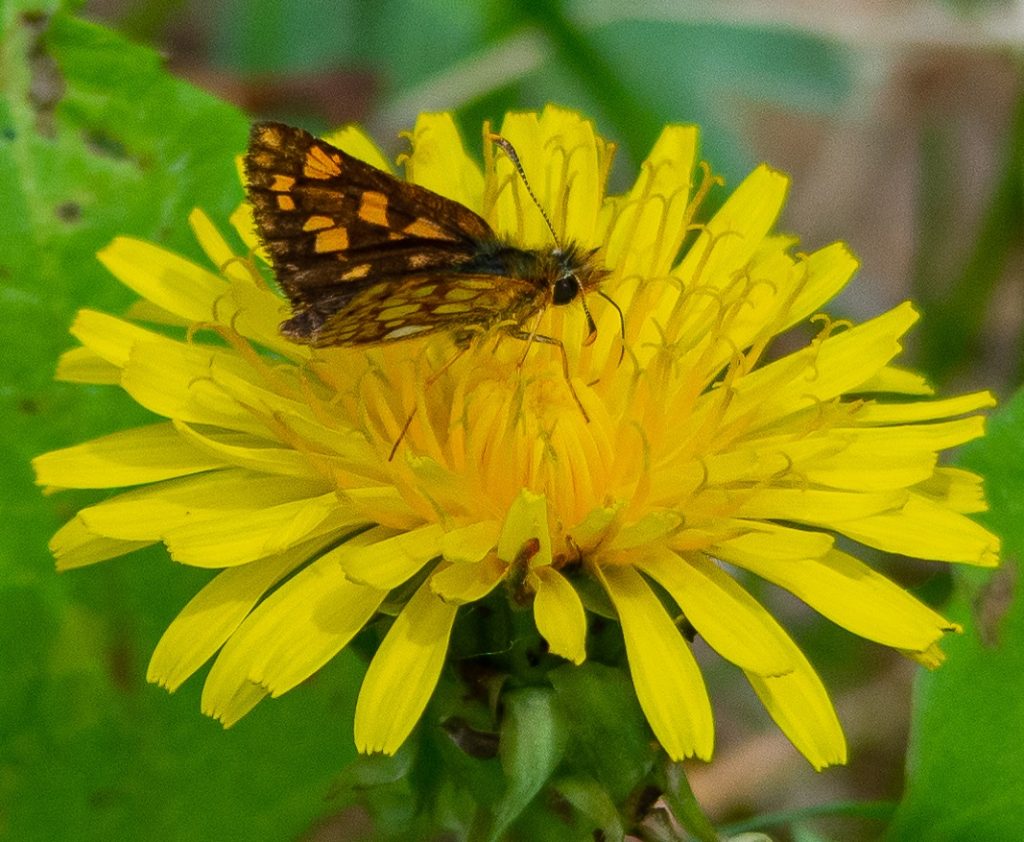
Arctic skipper (skipper family). Typical of skippers, this species has short, stubby wings and hook-ended antennae. The wings are orange and black, with silvery spots on the underside of the hindwings. It is found in meadows and woods throughout the province. Nick Carter
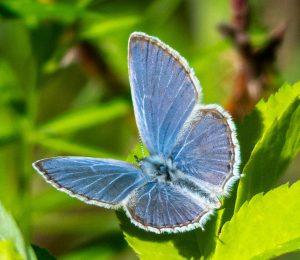
Western tailed-blue (gossamer-wings family). This is a small butterfly of woodlands in northern and central Alberta. The wing undersides are spotted and dull grey while the upper sides are metallic blue. Note the small pointed “tails” at the bottom of the hindwing on this species. Nick Carter
The gossamer-wings (family Lycaenidae) are a diverse family of small butterflies. They include the hairstreaks and coppers, but the group I most often see are the blues. The wings of butterflies in this family are larger than those of skippers and are fairly simple in shape — angular forewings and round hindwings. In blues, the wings are a beautiful metallic shade of blue on top, with some combination of subtle black spots and black-and-white edges depending on the species. Underneath, the wings are drab with black spots, though some have nice little red markings on the hindwing called auroras. With its small yet distinct hindwing “tails,” the western tailed-blue butterfly is a standout.
The whites and sulphurs (family Pieridae) are, as their name suggests, a group of mostly white and yellow butterflies. The mustard white butterfly, named for its preferred diet in the larval stage, is common in gardens, meadows, and forests. Its plain white wings with dark veins and yellow patches at the base of the forewings make it easy to identify. The similar cabbage white butterfly is an introduced species from Europe. It is a common pest of gardens and farms, with dark spots on the upper side of otherwise plain white wings. The greenish-yellow clouded sulphur butterfly, with its distinctive red spots on the underside of the hindwing, is a common species in the sulphur group.
Last but not least are the brushfoot butterflies (family Nymphalidae), which comprise the most diverse group, with over 6,000 species worldwide. Named for the fuzz on their reduced forelegs, these butterflies use only the four rear legs when standing. Several subgroups of this large, complex family are found across Alberta, including the admirals, fritillaries, satyrs, and anglewings. This family also includes the famous migratory monarch butterfly, which you may be lucky enough to spot in southern Alberta.
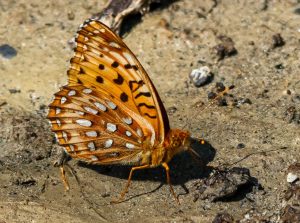
Aphrodite fritillary (fritillary subgroup of the brushfoot family). Like other fritillary species, this butterfly has orange-and-black wings with silver spots and a pale, crescent-shaped band on the hindwing undersides. Fritillaries can be hard to tell apart, but the black chevrons on the edge of the wings and brown eyes help this species stand out. It is found throughout much of the province in forests and open prairie. Nick Carter
A notable member of the admiral group is the regal white admiral, an easily recognizable species found in deciduous woods with black-and-white wings rimmed with red and blue spots on the hindwing. There’s also the monarch-mimicking viceroy.
The fritillaries are large, graceful butterflies with orange-and-black upper wings and variable patterns underneath. Fritillaries can be hard for novices to identify, but wing colours and patterns along with size and region found can help narrow things down. A common example is the variegated fritillary, which lives just about anywhere south of the boreal forest. Another group of much smaller orange-and-black butterflies are the crescents and checkerspots. The northern crescent is one of the most common summer butterflies north of the prairie grasslands. In the southeast it’s replaced by the similar pearl crescent.
Butterflies in the satyr group are subdued, brownish species found in prairies, meadows, and aspen woods. Many, such as the ringlet, northern pearly-eye, and common wood nymph have noticeable eyespot patterns on the wing undersides. These spots help deter bird predators and can be used to differentiate species, especially since satyrs always seem to perch with their wings folded up. Others in this group, like the alpines and Arctics, are more of a mothy grey and black.
Finally, there are the anglewings and their close relatives. In many species, when the wings are folded the camouflaged undersides show a dull brown colour, so they aren’t much to look at. But when the wings unfold, the vibrant colours of the upper sides are revealed. This group includes the lovely painted lady butterfly and its close relative the red admiral, both of which are migratory. Two of my favourite species, the Milbert’s tortoiseshell and mourning cloak butterfly, are common throughout the province, with adults toughing it out through winter in hibernation before awakening in early spring. The anglewings are known for their highly scalloped wing edges, coming in varying patterns of orange and black on the top side and dull brown below. Some have a white, comma-shaped mark under the hindwing, and so are referred to as the “commas.”
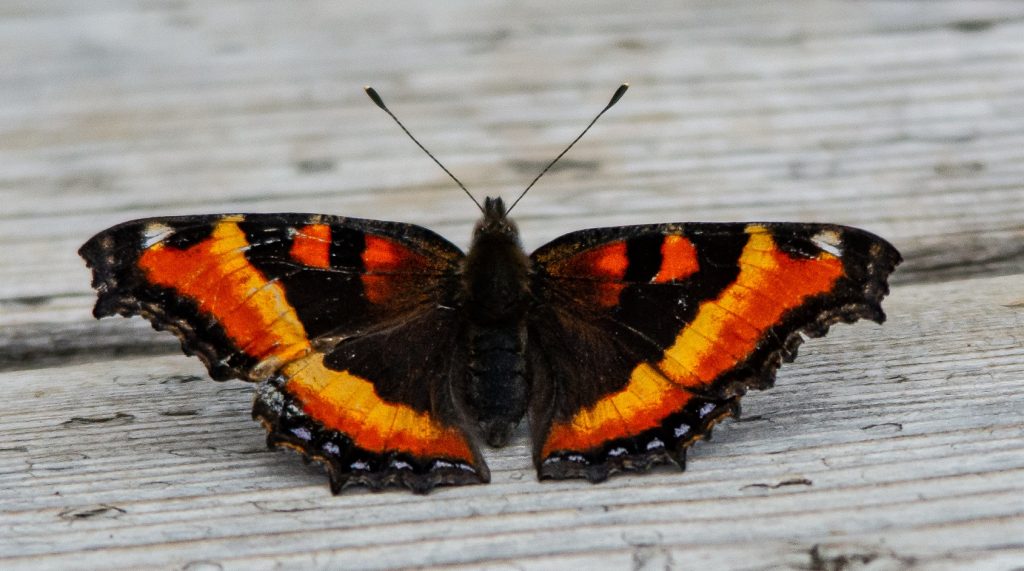
Milbert's tortoiseshell (anglewing subgroup of the brushfoot family). Vibrant bands of yellow and red on the upper side of its brown wings make this common butterfly easy to identify. Also note the red, eyelike patches and pale spots on each forewing. It is often seen standing on patches of bare, sunlit ground near wooded areas across the province. Nick Carter
Beginning Your Butterfly Watching Adventures
To learn more about butterflies, John Acorn’s book Butterflies of Alberta is a great resource. It provides an introduction to butterfly ecology and behaviour, as well as photographs and descriptions of the butterflies you are most likely to encounter in Alberta. The Insects of Alberta website is also a good resource for finding and identifying Alberta butterflies: insectsofalberta.com/butterflies.
There are many species to find and countless things to learn about Alberta’s butterflies. You can even start at home by engaging in “butterfly gardening,” a hobby that entails cultivating certain native flowers that are likely to attract different butterfly species. Finding these insects beyond the backyard is also a great excuse to get out and explore. Whether it’s high mountain meadows, sun-baked prairies, or deep northern woods, the butterflies will be waiting. Be sure to have the iNaturalist app loaded on your phone so that your observations will contribute to the citizen science database. And remember that, like all other natural history pursuits, butterfly watching is often best enjoyed in the company of other “rhopalocerophiles” — a label that any butterfly fan can wear with pride.
Nick Carter is a writer, photographer, and naturalist from Edmonton. From birds and bugs to flowers and fossils, Nick is always seeking out the natural wonders of this province and sharing his enthusiasm with others.
This article originally ran in Nature Alberta Magazine – Spring 2023.
